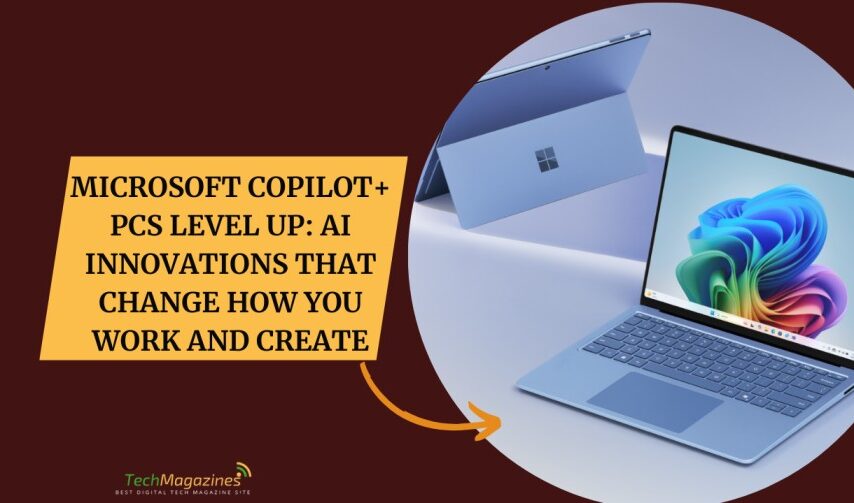Microsoft has taken a bold step in shaping the future of personal computing with the introduction of Copilot+ PCs, a new class of AI-powered Windows devices. Crafted to boost user productivity, creativity, and accessibility, these machines operate using Neural Processing Units (NPUs) to handle AI-specific workloads, which are hundreds of times faster and more efficient than normal PCs.
Microsoft wants to revolutionize the way users interact with their devices, and for that, the solution calls for blending the latest hardware with an intelligent operating system. Then let’s look at what differentiates Microsoft Copilot+ PCs from their competition and how their latest AI takes computing to an all-new level.
What Are Microsoft Copilot+ PCs?
New to Windows 11, Microsoft Copilot+ PCs are a new kind of Windows 11-powered dedicated Neural Processing Units (NPUs) that can execute trillions of AI operations per second. Powerful processors from Qualcomm, AMD, and Intel backed these devices with high performance in both applications.
Built deep into the system, both local AI and cloud customization allow Microsoft’s Copilot AI assistant to enhance the user experience. With Copilot+ PCs, speed, efficiency, and next-generation capabilities are balanced with the power of Microsoft’s Azure AI models running on the device.
Key Features of Copilot+ PCs
These devices come prepared with many AI-based functions that revolutionize how users perform their work as well as interact with their computers.
1. Recall: A Photographic Memory for Your PC
‘The recall’ in Copilot+ PCs is one of the standout features, making it simple for users to return to their previous computer activities. Recall is different from conventional search because it contextualizes and recovers past interactions: you can find a document, web page, or conversation through associations, rather than a filename.
Imagine that you worked on a project last month, and you spoke about it in a Microsoft Teams meeting; Recall can present instantly the relevant files, conversations and notes, easing the flow of your workflows and making them intuitive.
2. Live Captions with Real-Time Translation
Copilot+ PCs provide real-time transcription features that also act as translation solutions between over 40 languages. The functionality enables spoken word conversion from more than 40 languages into English during offline operations. The addition of this feature provides freedom of access to auditory information for deaf users and enables international teams to communicate effortlessly.
3. Cocreator: AI-Powered Image Generation
Through Cocreator, artists and designers use an AI-driven system that operates directly on their device for creating and modifying images. Cocreator operates locally on the NPU, ensuring faster, more secure rendering without requiring an internet connection.
4. Enhanced Windows Studio Effects for Video Calls
Windows Studio Effects suite provides virtual meeting users with numerous features that improve their meeting quality through functions such as:
- Automatic framing to keep users in focus.
- Background blur for a distraction-free environment.
- Voice focus for noise cancellation.
- Eye contact correction, making virtual interactions feel more natural.
5. Upcoming AI Features in 2025
Microsoft will introduce further AI-powered updates in 2025 featuring multiple new features, among them:
- Click to Do: Provides users with an effortless tool for workflow automation in repetitive tasks.
- Improved Windows Search: Smarter, AI-powered search capabilities.
- Super-Resolution in Photos: Automatically enhances image quality.
- Generative Fill and Erase in Paint: Advanced AI tools for seamless image editing.
- Enhanced Recall Security Settings: More user control over data privacy and access.
6. Advanced Security Features
Every PC equipped with Microsoft’s Pluton security processor, along with secured-core PC architecture, receives top priority for security features. These features:
- Protect against malware and cyber threats.
- Offer personalized privacy controls.
- Safeguard sensitive data with enhanced encryption.
Performance and Compatibility
The Copilot+ PCs incorporate an integration of on-device Small Language Models and Microsoft’s Azure-powered Large Language Models with Non-Performance Units to manage AI workloads smoothly. Users benefit from quick, reliable, and powerful performance through this combined AI system that operates in multiple applications.
The devices allow users to run an increasing number of applications optimized for Arm64 technology which includes professional tools such as Microsoft 365 apps along with Adobe Photoshop and Blender.
The Competitive Landscape
Microsoft faces rivalry with companies such as Apple due to its AI computing direction as Apple introduces M4-powered iPad Pro and other AI devices to its product line.
The NPU-specific integration, combined with extensive AI features in Microsoft systems, creates a leading advantage for transforming modern PC functionality.
Availability and Future Roadmap
Microsoft started accepting pre-orders for Copilot+ PCs in May 2024 before launching them to general customers through their availability on June 18, 2024. Devices that integrate the Snapdragon X Elite chip from Qualcomm represent the first devices on the market, but Intel and AMD-powered Copilot+ PCs will gain feature updates until early 2025.
Microsoft maintains a policy for ongoing AI software updates to keep Copilot+ devices ahead in terms of technological innovation. The future development of Copilot+ PCs will increase through software developers who optimize their applications for AI-enhanced computing performance.
Conclusion
Personal computing evolution took a major step forward when Microsoft implemented AI deeply into its computer hardware and operating software through Copilot+ PCs. These groundbreaking features, along with Recall and real-time translation, AI-powered image generation, and enhanced security, will transform productivity and creativity in digital workplaces. Through ongoing AI updates from Microsoft until 2025, Copilot+ PCs will transition into essential products that assist all groups, including professional and art creators and normal users, by turning basic computer systems into smart daily life tools.








